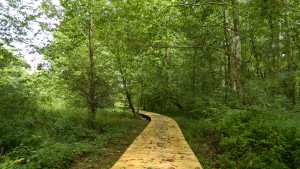“Silence isn’t the absence of something, but the presence of everything.” - Gordon Hempton
With snow-quilted Ohio winters comes a deep silence. When temperatures fall and sifted snow begins to stick to the ground, there is a cue for nature to fall into quiet patterns. Many birds migrate to warmer climates, some animals curl into pockets of hibernation in order to survive. Humans, too, develop slower, more insulated habits, tucking themselves indoors. But there is a subtler reason for the hush — one beyond preservational instincts — rooted in snow crystal acoustics.
Snow has the ability to absorb sound waves due to snowflakes’ hollow crystalline structure. Snowfalls have a 50-90% sound absorption rating, meaning a dense layer of snow can mute the majority of noises from the outside world.
With the arrival of winter at the BFEC, many people seek the nurturing silence of winter hikes. But despite places like the BFEC, there are few places left where we can experience silence. This alarming trend is catching the attention of researchers: silence is on the verge of extinction.
Across the United States, noise pollution is affecting more and more natural spaces. Noise pollution is not always as obvious as a foghorn or a rumbling helicopter. When studying the loss of quiet, scientists seek to preserve what American auditory ecologist Gordon Hempton describes as “silence from noise pollution of modern life — sounds that have nothing to do with the natural acoustic system.” Hempton alludes to noise pollution including the most subtle sounds like the distant whir of cars on provincial roads, the rumble of the cooling system in freezers, even the hum funneled into our ears by noise-cancelling headphones.
Hempton is one of the researchers on the forefront of Western science’s realization that silence truly matters — for the health of nature and humans alike. A physical, natural space is more than the quality of light, the diversity of plant life, even the direction of the wind. Natural sounds are a vital piece of a habitat, and the clean base-layer of silence allows organisms to communicate with each other, find food, and avoid predators. Quiet also benefits humans, as interacting with a peaceful auditory landscape reduces anxiety, ameliorates the risk of chronic health issues and improves sleep quality. In fact, in Yale's environmental publication Environmental 360’s essay on silence, Norwegian epidemiologist Marie Pedersen shares that “[Human-created] noise is a known psychological and physiological stressor.”
Studies in the last decade have reported that human noise doubled the din of background noise in 63% of protected natural American spaces. Even more tragically, studies have shown that 90% of children will not experience the pure silence that scientists like Greg Hempton are fighting to preserve.
Hempton is striving to prevent this tragedy from expanding through the establishment of projects like One Square Inch of Silence. Located in the Hoh Rain Forest at Olympic National Park, a red painted rock indicates what is believed to be one of the last remaining bubbles of silence in America. Although National Park policies do not address the protection of quiet, One Square Inch of Silence strives to draw attention to and build appreciation for true, complete natural silence. The project has expanded into Quiet Parks International (QPI), a non-profit whose mission is “to save quiet for the benefit of all life.” QPI does this by awarding Quiet Park certifications to public spaces, urban areas, and trails all over the globe. They are developing a Quiet Research program that involves scientists, musicologists, citizens, and researchers to document the world’s auditory landscapes.
QPI strives to protect the delicate details of natural spaces that are vital to the wellbeing of humanity and nature. This winter, when you pad through the soft drifts of snow, take a moment to appreciate the heightened sense of quiet. It is our hope that appreciation becomes advocacy, and advocacy becomes preservation of our natural world — sight, silence and all.
